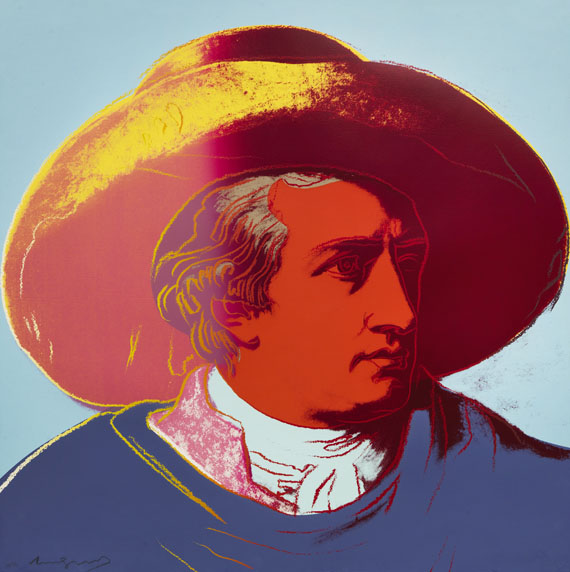Asta: 535 / Evening Sale with Collection Hermann Gerlinger del 09 dicembre 2022 a Monaco di Baviera  Lot 13
Lot 13
 Lot 13
Lot 13
13
Andy Warhol
Goethe, 1982.
Silkscreen in colors
Stima:
€ 300,000 / $ 330,000 Risultato:
€ 475,000 / $ 522,500 ( commissione inclusa)
Goethe. 1982.
Silkscreen in colors.
Feldmann/Schellmann/Defendi II.270-273. Signed, numbered and inscribed "PP“. The complete set of 4 sheets, each PP copy 5/5 aside from the edition of 100. On Lenox Museum cardboard. 96.5 x 96.5 cm (37.9 x 37.9 in), the full sheet.
Printed by Rupert Jasen Smith, New York (with the blindstamp). Published by Editionen Schellmann & Klüser, Munich/New York, in cooperation with Denise René/Hans Mayer, Düsseldorf (verso with the copyright stamp).
• Extremely rare as complete series and matching set.
• An icon of world literature portrayed by Warhol.
• Heinrich Wilhelm Tischbein's painting becomes an icon of pop art.
LITERATURE: Forty are better than one. Edition Schellmann 1969-2009, published by Jörg Schellmann, Ostfildern 2009, pp. 342-343.
Andy Warhol, quoted from: Andrea Bordbeck et al (ed.), Andy Warhol. A Factory, Ostfildern 1998, no p.
Silkscreen in colors.
Feldmann/Schellmann/Defendi II.270-273. Signed, numbered and inscribed "PP“. The complete set of 4 sheets, each PP copy 5/5 aside from the edition of 100. On Lenox Museum cardboard. 96.5 x 96.5 cm (37.9 x 37.9 in), the full sheet.
Printed by Rupert Jasen Smith, New York (with the blindstamp). Published by Editionen Schellmann & Klüser, Munich/New York, in cooperation with Denise René/Hans Mayer, Düsseldorf (verso with the copyright stamp).
• Extremely rare as complete series and matching set.
• An icon of world literature portrayed by Warhol.
• Heinrich Wilhelm Tischbein's painting becomes an icon of pop art.
LITERATURE: Forty are better than one. Edition Schellmann 1969-2009, published by Jörg Schellmann, Ostfildern 2009, pp. 342-343.
Andy Warhol, quoted from: Andrea Bordbeck et al (ed.), Andy Warhol. A Factory, Ostfildern 1998, no p.
De-contextualized and in a striking orchestration, Andy Warhol presents us one of the most famous German poets of all time - Goethe with the unmistakable hat, as depicted by Johann Heinrich Wilhelm Tischbein in his painting "Goethe in der Campagna" around 1786/87. Warhol excised him from the landscape surroundings in the painting and transferred the face of the great poet into the square form of his serigraph. Rendered in loud colors and with bold contour lines, Goethe joins the array of celebrities portrayed by Warhol. Since the late 1970s, the artist had not only devoted himself to depicting his contemporaries, but also found important sources of inspiration in the paintings of Old Masters and other cultural symbols. In the special case of his Goethe suite, not only two epochs, different nationalities, styles and mental attitudes come together in one serigraph, the celebrated American artist also confronts us with a new interpretation of what is probably the most well-known portrait of Goethe, and surpasses Tischbein's portrayal by translating the motif into an unmistakable statement of pop art.
In this context, the close interdependence with German art and the cultural landscape is not only emphasized by the motifs of the four serigraphs but also by their genesis: When Warhol was invited to Frankfurt in context of a portrait commission from the publisher Siegfried Unseld in 1980, they visited the Städel Museum together. In front of Tischbein's painting, Unseld is said to have encouraged the pop artist to use the motif for his own work. In addition to large-format representations on canvas, Warhol conceived the series of serigraphs with this motif in 1982. This unique suite, as well as the entire later creative period of the artist were also shaped by the close collaboration with the publishers Jörg Schellmann and Bernd Klüser. From around 1970, Schellmann in particular was one of the most important editors of contemporary editions with artists such as Joseph Beuys, Keith Haring and Hanne Darboven. In 1980, when Schellmann & Klüser published the artist's first serial work, the famous portrait of Joseph Beuys, an extremely fruitful cooperation with Andy Warhol began. Up until Warhol's death in 1987, more than 20 other editions were created as part of this collaboration, which offered the pop art pioneer a valuable platform for the distribution of his iconic, mass-consumption-oriented serigraphs - loosely based on his self-declared motto ‘Thirty Are Better Than One’. The popular and rare Goethe suite is one of them. [AM]
In this context, the close interdependence with German art and the cultural landscape is not only emphasized by the motifs of the four serigraphs but also by their genesis: When Warhol was invited to Frankfurt in context of a portrait commission from the publisher Siegfried Unseld in 1980, they visited the Städel Museum together. In front of Tischbein's painting, Unseld is said to have encouraged the pop artist to use the motif for his own work. In addition to large-format representations on canvas, Warhol conceived the series of serigraphs with this motif in 1982. This unique suite, as well as the entire later creative period of the artist were also shaped by the close collaboration with the publishers Jörg Schellmann and Bernd Klüser. From around 1970, Schellmann in particular was one of the most important editors of contemporary editions with artists such as Joseph Beuys, Keith Haring and Hanne Darboven. In 1980, when Schellmann & Klüser published the artist's first serial work, the famous portrait of Joseph Beuys, an extremely fruitful cooperation with Andy Warhol began. Up until Warhol's death in 1987, more than 20 other editions were created as part of this collaboration, which offered the pop art pioneer a valuable platform for the distribution of his iconic, mass-consumption-oriented serigraphs - loosely based on his self-declared motto ‘Thirty Are Better Than One’. The popular and rare Goethe suite is one of them. [AM]
13
Andy Warhol
Goethe, 1982.
Silkscreen in colors
Stima:
€ 300,000 / $ 330,000 Risultato:
€ 475,000 / $ 522,500 ( commissione inclusa)





